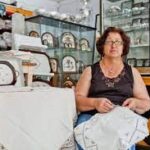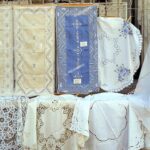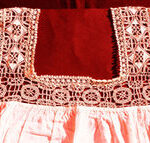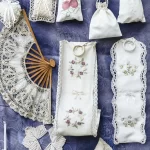CYPRUS LEFKARA LACE
It was the Venetians who inspired the creation of Lefkara lace in Cyprus, as during their occupation (1489-1571) the ruling classes would go and holiday in the village of Lefkara. The local women copied the fine embroidery of the Venetian’s clothes, and adapted their own designs based on what they saw. Soon, this fine lace work became world famous; Leonardo da Vinci even came to Cyprus to buy Lefkara lace for Milan Cathedral





Distinctive features of Lefkara lace from Cyprus
Cyprus Lefkara lace is quite distinctive, through its use of white, brown and beige threads – and its international origins! The linen cloth that forms the basis for the lace is imported from Ireland, whilst the thread is French DMC cotton perle thread. The other distinctive feature of fine Lefkara lace from Cyprus is that there is no difference between the front and back of any piece.
Venetian lace - in Cyprus!
The oldest Cyprus lace is based on the Venice models is called Lefkara needlework, and it is extremely intricate work. This is such fine lace that you will not find it on Cyprus market stalls, but instead at good shops and craft centres. The lace you see in the markets is known as lace embroidery, or crochet work, which comes in a wide variety of designs. The final type of lace is the coloured lace used to edge traditional headscarves, collars and shirts.
An ancient craft of Cyprus
Cyprus Lefkara needlework lace is always made by hand. You may well see Turkish Cypriot ladies stooped over a cushion or pillow on their lap, sitting in the shade of a tree, working the lace as they have done for centuries. The design for Lefkara lace is first drawn onto paper, and then a second sheet placed over this. The design shows through the second sheet of paper, which means the lace doesn’t get dirty, or the design get rubbed off! Needles are placed along the design outline, and a thread tied to the front-most needle. The thread is then run around the outside of all the needles and tied to the last needle. Once three layers of such threads have been built up, they are stitched together just like a buttonhole. Gradually, the lace starts to form, rising out from the paper base, and decorated with special knots to hold the design in place. The result is incredibly delicate, intricate and a true labour of love
Lefkara embroidery from Northern Cyprus
North Cyprus Lefkara embroidery is different again, where linen cloth is embroidered with traditional motifs. Some shapes are made using cut-work (gofti), where some of the linen threads are carefully cut away to leave a ‘hole’ in the fabric. The edges of the hole shapes are hemmed, to produce little ‘windows’ in the finished articles. Like the Venetian lace, the embroidery is worked mounted on a pillow, using needles. The designs are carefully outlined in hem stitch, and the edges of the cloth also hemmed. The whole cloth is then edged with lace, either the fine narrow ‘tsimbi’ lace or the wider ‘glosi’ lace. Lefkara embroidery used to be part of every Turkish Cypriot’s life, because the distinctive white embroidery on white cloth was always included in a bride’s trousseau.
The best places to buy North Cyprus lace
To see the best examples, visit the Folk Arts Institute, shops in the buyuk han and the Handicrafts Centres in North Cyprus. Also, look for the El Sanatlari Kooperatifi sign, showing the items come from the Handicrafts Cooperative, and is authentic North Cyprus work. A show of Northern Cyprus crafts is held every year in May, near the Ataturk Stadium in North Cyprus.